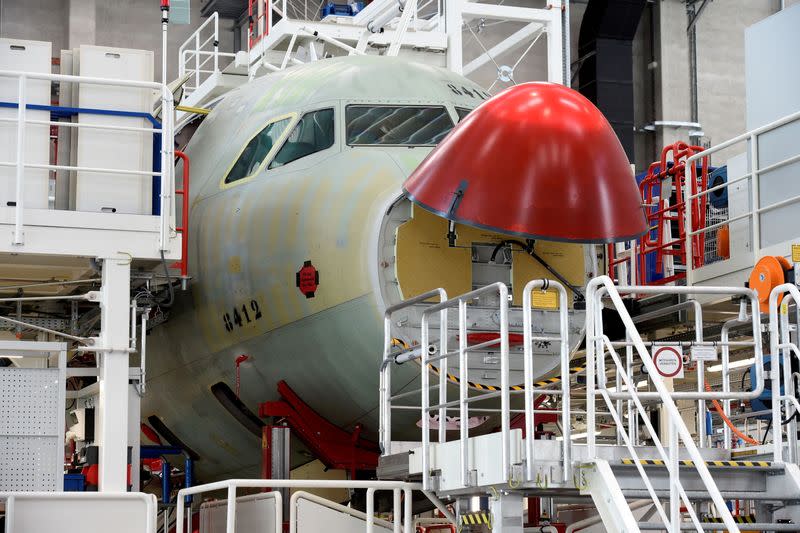Analysis-Planemakers talk up 'surge capacity' amid industrial woes
By Tim Hepher and Valerie Insinna
PARIS/WASHINGTON (Reuters) -Planemakers have signalled a shift in production strategy to make factories more resilient to recent supply disruptions by adding "surge capacity," even where that means extra cost.
Leaders of Airbus and Boeing have both used the term in recent days - which can include expanding factory space and hiring more staff - as the aerospace industry struggles to tame post-COVID disruption now in its fourth year.
The move comes as experts warn delays that have seen Airbus reset hundreds of 2024 deliveries could stretch to 2026, though both groups confirmed underlying output goals on Tuesday.
"We live in a supply constrained environment ... Our focus is on both capacity and quality. Like many in the industry, we do expect another challenging year for the supply chain," Boeing Chief Executive Dave Calhoun told shareholders.
"To support the supply chain, we've increased on-site presence, we've ramped up internal fabrication for surge capacity and we've increased inventory of select parts for risk protection."
Airbus, which holds its annual meeting on Wednesday, is also building in more spare margin as it targets a two-thirds rise in core production to 75 jets a month in 2026.
Chief Executive Guillaume Faury this month agreed to open a new assembly line in China, bringing to 10 the number of single-aisle plants worldwide. Its target is the Chinese market but it complements an expanding European and U.S. network.
"It is a way to be probably more in sync with the way the world is developing, with tensions and with more complexities of doing business," Faury told reporters.
"Ten lines for rate 75 is also an opportunity to have what we call surge capacity, to be able to recover in case we have difficulties, but also to absorb difficulties here and there and be able to focus on the market when it is moving forward."
DEFENDING AVERAGE OUTPUT
Planemakers only rarely speak of "surge capacity" in the aerospace production system, which is seen as more capital-intensive and less nimble than in consumer-facing industries.
But a person familiar with the change of direction said Faury was also doubling down on the monthly target of 75 after it was delayed by a round a year amid scepticism from suppliers.
Instead of a series of peaks, surge capacity would allow Airbus to defend that rate on an average basis, the person said, noting that similar tactics had been used in the auto sector where Faury spent several years between stints at Airbus.
Although auto firms rely heavily on overtime to meet peak demand, analysts say there are examples of automakers installing surge capacity for a successful product. General Motors took such a gamble in Canada to assemble more pickups in 2020.
The risk is that when demand slows the added capacity and inventory may no longer be profitable. Yet the stakes of sticking to previous just-in-time methods are just as high.
"That might not be viable in a world where we have to worry about pandemics and disruptions like the Ukraine war and sudden oil shocks, financial crises," said Doug Royce, aerospace analyst at Forecast International.
"You need to be able to prepare to weather storms in a way that maybe you didn't think you had to in pre-COVID days."
A senior manufacturing source said the strategy made sense as long as neither company over-invested in spare capacity.
"It is logical depending on the percentage of the ‘surge,’ otherwise you just have excess people," the source said.
Calhoun acknowledged the looser industrial set-up was having an impact on performance but added "the worst is behind us".
Airbus' tactics also reflect a shift towards the in-demand A321neo variant, whose range makes it suitable for long trips but whose narrow fuselage and quick assembly are hard to reconcile with the installation of customised premium seats.
While an A320 assembly line typically runs in current circumstances at around eight planes a month, sources say the 30% of extra work needed to build an A321 means lines can handle as few as six planes a month when fully deployed on that type.
That implies a blended capacity of seven planes a month per line based on the 50-50 mix of A321 and A320 in latest deliveries - a ratio expected to tilt towards 60% A321s based on future orders.
Airbus may therefore add more single-aisle lines at about $200 million each, one industry source said, with part of the former A380 assembly hall in Toulouse still lying vacant.
"Everyone is learning lessons from the ramp-up. Things just got a little too lean," said Aerodyamic Advisory managing director Richard Aboulafia.
(Reporting by Tim Hepher and Valerie InsinnaEditing by Mark Potter)

 Yahoo Finance
Yahoo Finance 

